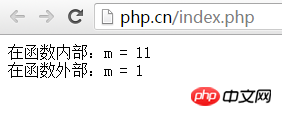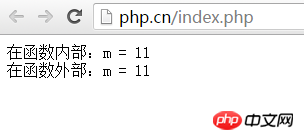 Backend Development
Backend Development
 PHP Tutorial
PHP Tutorial
 Detailed explanation of three ways to pass parameters of PHP custom functions between functions
Detailed explanation of three ways to pass parameters of PHP custom functions between functions
Detailed explanation of three ways to pass parameters of PHP custom functions between functions
When calling a function, you need to pass parameters to the function. The passed parameters become actual parameters, and the parameters when the function is defined are formal parameters. In the previous chapter, we explained the parameters of php custom functions with examples. This chapter focuses on the three ways of passing parameters between functions: Pass by value , Pass and default parameters by reference.
1. Pass by value
#Assign the value of the actual parameter to the corresponding formal parameter, and the operation inside the function is for The formal parameters are processed, and the result of the operation will not affect the actual parameters, that is, the values of the actual parameters will not change after the function returns. During the pass-by-value process, the formal parameters of the called function are treated as local variables of the called function, that is, a memory space is opened in the stack to store the values of the actual parameters put in by the calling function, so that Becomes a copy of the actual parameter. The characteristic of value transfer is that any operation of the formal parameters by the called function is performed as a local variable and will not affect the value of the actual parameter variable of the calling function.
First define a function example(), whose function is to perform some operations on the passed parameter value and then output it; then define a variable $m outside the function, which is the actual parameter; finally call the function example($ m). Output the values of formal parameter $m and actual parameter $m inside and outside the function body respectively.
The example code is displayed as follows:
<?php
function example($m){
$m = $m + 10;
echo "在函数内部:m = ".$m ."<br>"; //输出形参的值
}
$m = 1;
example($m); // 将实参$m的值传递给形参$m
echo "在函数外部:m = ".$m; // 实参的值没有变化,$m = 1
?>The running result of the function is as follows:

2. Passing by reference
Passing by reference is to pass the memory address of the actual parameter to the formal parameter. At this time, all operations on the formal parameters within the function will affect the values of the actual parameters. After the function returns, the value of the actual parameter will change. The way to pass by reference is to add the "& " symbol in front of the formal parameter when defining the function. During the pass-by-reference process, although the formal parameters of the called function also open up memory space on the stack as local variables, what is stored at this time is the address of the actual parameter variable put in by the calling function. Any operation of the called function on the formal parameters is processed as indirect addressing, that is, the actual parameter variables in the calling function are accessed through the address stored in the stack. Because of this, any operation the called function does on the formal parameters affects the actual parameter variables in the calling function.
The code example is as follows:
<?php
function example(&$m){ //定义一个函数,同时传递参数$m的地址
$m = $m + 10;
echo "在函数内部:m = ".$m ."<br>"; //输出形参的值
}
$m = 1;
example($m); // 将实参$m的地址传递给形参$m
echo "在函数外部:m = ".$m; // 实参的值发生了变化,$m = 11
?>The running result of the function is as follows:

3. Default parameters (optional parameters)
There is another way to set parameters, which is optional parameters. You can specify a parameter as optional, place the optional parameter at the end of the parameter list, and specify that its default value is empty.
Application example uses optional parameters to implement a simple price calculation function. Set the parameter $tax of the custom function values as an optional parameter, and its default value is empty. The first time the function is called, and the parameter $tax is assigned a value, the price is output; the second time the function is called, the parameter is not copied, and the price is output.
The code is as follows:
<?php
function value($price, $tax=""){ //定义一个函数,第二个参数为空
$price = $price*$tax;
echo "价格:$price<br>"; //输出价格
}
value(10,5); // 为可选参数赋值5
value(10); // 没有给可选参数赋值
?>The output result is:
Price: 50
Price: 0
Note: When using default parameters, the default parameters must be placed to the right of the non-default parameters, otherwise the function may Something went wrong.
Note: Starting from PHP5, default values can also be passed by reference. The next chapter will introduce What is the return value of a custom function.
【Recommended related tutorials】
1. "php.cn Dugu Jiujian (4)-php video tutorial"
2. php programming from entry to mastering a full set of video tutorials
3. php practical video tutorial
The above is the detailed content of Detailed explanation of three ways to pass parameters of PHP custom functions between functions. For more information, please follow other related articles on the PHP Chinese website!

Hot AI Tools

Undresser.AI Undress
AI-powered app for creating realistic nude photos

AI Clothes Remover
Online AI tool for removing clothes from photos.

Undress AI Tool
Undress images for free

Clothoff.io
AI clothes remover

Video Face Swap
Swap faces in any video effortlessly with our completely free AI face swap tool!

Hot Article

Hot Tools

Notepad++7.3.1
Easy-to-use and free code editor

SublimeText3 Chinese version
Chinese version, very easy to use

Zend Studio 13.0.1
Powerful PHP integrated development environment

Dreamweaver CS6
Visual web development tools

SublimeText3 Mac version
God-level code editing software (SublimeText3)

Hot Topics
 1664
1664
 14
14
 1423
1423
 52
52
 1317
1317
 25
25
 1268
1268
 29
29
 1246
1246
 24
24
 Explain JSON Web Tokens (JWT) and their use case in PHP APIs.
Apr 05, 2025 am 12:04 AM
Explain JSON Web Tokens (JWT) and their use case in PHP APIs.
Apr 05, 2025 am 12:04 AM
JWT is an open standard based on JSON, used to securely transmit information between parties, mainly for identity authentication and information exchange. 1. JWT consists of three parts: Header, Payload and Signature. 2. The working principle of JWT includes three steps: generating JWT, verifying JWT and parsing Payload. 3. When using JWT for authentication in PHP, JWT can be generated and verified, and user role and permission information can be included in advanced usage. 4. Common errors include signature verification failure, token expiration, and payload oversized. Debugging skills include using debugging tools and logging. 5. Performance optimization and best practices include using appropriate signature algorithms, setting validity periods reasonably,
 Explain late static binding in PHP (static::).
Apr 03, 2025 am 12:04 AM
Explain late static binding in PHP (static::).
Apr 03, 2025 am 12:04 AM
Static binding (static::) implements late static binding (LSB) in PHP, allowing calling classes to be referenced in static contexts rather than defining classes. 1) The parsing process is performed at runtime, 2) Look up the call class in the inheritance relationship, 3) It may bring performance overhead.
 What are PHP magic methods (__construct, __destruct, __call, __get, __set, etc.) and provide use cases?
Apr 03, 2025 am 12:03 AM
What are PHP magic methods (__construct, __destruct, __call, __get, __set, etc.) and provide use cases?
Apr 03, 2025 am 12:03 AM
What are the magic methods of PHP? PHP's magic methods include: 1.\_\_construct, used to initialize objects; 2.\_\_destruct, used to clean up resources; 3.\_\_call, handle non-existent method calls; 4.\_\_get, implement dynamic attribute access; 5.\_\_set, implement dynamic attribute settings. These methods are automatically called in certain situations, improving code flexibility and efficiency.
 PHP and Python: Comparing Two Popular Programming Languages
Apr 14, 2025 am 12:13 AM
PHP and Python: Comparing Two Popular Programming Languages
Apr 14, 2025 am 12:13 AM
PHP and Python each have their own advantages, and choose according to project requirements. 1.PHP is suitable for web development, especially for rapid development and maintenance of websites. 2. Python is suitable for data science, machine learning and artificial intelligence, with concise syntax and suitable for beginners.
 PHP in Action: Real-World Examples and Applications
Apr 14, 2025 am 12:19 AM
PHP in Action: Real-World Examples and Applications
Apr 14, 2025 am 12:19 AM
PHP is widely used in e-commerce, content management systems and API development. 1) E-commerce: used for shopping cart function and payment processing. 2) Content management system: used for dynamic content generation and user management. 3) API development: used for RESTful API development and API security. Through performance optimization and best practices, the efficiency and maintainability of PHP applications are improved.
 PHP: A Key Language for Web Development
Apr 13, 2025 am 12:08 AM
PHP: A Key Language for Web Development
Apr 13, 2025 am 12:08 AM
PHP is a scripting language widely used on the server side, especially suitable for web development. 1.PHP can embed HTML, process HTTP requests and responses, and supports a variety of databases. 2.PHP is used to generate dynamic web content, process form data, access databases, etc., with strong community support and open source resources. 3. PHP is an interpreted language, and the execution process includes lexical analysis, grammatical analysis, compilation and execution. 4.PHP can be combined with MySQL for advanced applications such as user registration systems. 5. When debugging PHP, you can use functions such as error_reporting() and var_dump(). 6. Optimize PHP code to use caching mechanisms, optimize database queries and use built-in functions. 7
 The Enduring Relevance of PHP: Is It Still Alive?
Apr 14, 2025 am 12:12 AM
The Enduring Relevance of PHP: Is It Still Alive?
Apr 14, 2025 am 12:12 AM
PHP is still dynamic and still occupies an important position in the field of modern programming. 1) PHP's simplicity and powerful community support make it widely used in web development; 2) Its flexibility and stability make it outstanding in handling web forms, database operations and file processing; 3) PHP is constantly evolving and optimizing, suitable for beginners and experienced developers.
 Explain the match expression (PHP 8 ) and how it differs from switch.
Apr 06, 2025 am 12:03 AM
Explain the match expression (PHP 8 ) and how it differs from switch.
Apr 06, 2025 am 12:03 AM
In PHP8, match expressions are a new control structure that returns different results based on the value of the expression. 1) It is similar to a switch statement, but returns a value instead of an execution statement block. 2) The match expression is strictly compared (===), which improves security. 3) It avoids possible break omissions in switch statements and enhances the simplicity and readability of the code.



